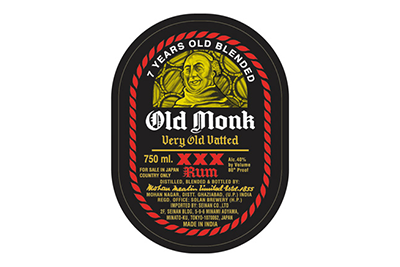Even if you were a teetotaller, you wouldn’t have missed the news of the demise of Old Monk’s creator Brigadier (retd.) Kapil Mohan recently. That’s because its fans and many brands paid tribute to him on social media.
The sheer no. of messages would give an impression that Old Monk remains India’s most loved liquor brand even today. Sadly, it is not so, at least in terms of consumption.
Here's another Indian case study by India Brand Review.
Its birth and rise
While the brewery that makes Old Monk was established in 1855, the brand Old Monk was launched almost a century later, in 1954, by a company called Mohan Meakin Pvt. Ltd.
Since launch, it has been a great combination of quality, taste, and price. Its unique taste comes from 7 years of ageing and was considered way better than other dark rums in the market. The colour made consumption easier by slyly mixing it with Coke or Thums Up. Plus, it doesn’t give a hangover. This taste has remained almost the same since its birth.
With a near 50% alcohol content, it was considered a man’s drink. Being the favourite of the Indian Army and Navy added to its image and exclusivity, and distribution. And with a price tag that made it affordable even for college students, its rise to the top seems almost obvious in hindsight.
No wonder then, that Old Monk commanded great loyalty, without ever having to spend on advertising. From professional networks like Ryze to Pages on Facebook, customers had themselves created fan clubs, some giving themselves elaborate names like COMRADE (the Council of Old Monk Rum Addicted Drinkers and Eccentrics). There was/is even an OMAXI (Old Monks Association of XLRI) at XLRI, Jamshedpur.
With all this going for it, the business couldn’t succeed. Up until 2002, it was the undisputed single brand leader in the entire branded spirits market in India. The next brand was Bagpiper, a whisky produced by United Spirits. The closest rum competition came from McDowell’s Celebration Rum that sold less than half the volume at that time.
And then came the fall
Soon after 2002, the brand started declining, and competitors grew stronger. By 2005, Celebration Rum overtook Old Monk in sales volume. By 2011, Old Monk sales had dropped to barely 3 million cases. In comparison, Celebration Rum sold over 11 million cases.
It continued to get worse. By 2014, Celebration Rum was selling more than 7 times the volume of Old Monk. The once-iconic brand was now at barely half its sales volume from less than 10 years ago. This same year, its maker posted a loss of almost Rs. 20 crore. Then in 2015, it had to fight a scare that the brand was going out of production.
The brand that enjoyed a fairy-tale-like success was living a nightmare-like downfall.
So, what went wrong?
How could a brand like Old Monk see such a collapse?
The fall of Old Monk can be attributed largely to 2 factors – distribution and a deteriorated brand image.
For a liquor brand, managing logistics and retail distribution is a critical component of a business. Moreover, it also needs to be agile to respond to changing govt. policies. Old Monk failed on both fronts. It had outsourced its distribution to third parties. And failed to monitor them strictly. This ultimately led to poor decisions regarding the trade channel. In comparison, its biggest competitor McDowell’s Celebration Rum owned by United Spirits grew its distribution on back of its larger brand portfolio allowing more negotiation power and good trade incentives.
Mohan Meakin also fell victim to changes in govt. policies. A new rule in UP led to shutting down its brewery in Lucknow, and a state-takeover of liquor sales in Tamil Nadu meant overnight disappearance from the shelves of one of the largest rum consuming states in India.
But the biggest culprit of Old Monk’s fall from grace seems to be its brand management.
As foreign brands and a variety of liquors entered the Indian market, they took away the lifestyle tag from Old Monk. This brand with a great following would soon find itself relegated to the last position in menus of Indian bars and hotels – stocked for the hardcore loyalists but nowhere considered appropriate to be drunk by the majority.
The new class of consumers earned enough money to indulge in premium whiskies and generally more expensive brands. Quite interestingly, McDowell’s Celebration Rum increased its prices to tap into this new mindset, while Old Monk stayed cheap, and lost its sheen. By 2008, it had lost its distinction of being the Indian Army’s most-loved drink.
It is felt that one of the reasons why Old Monk lost touch with the market and with its business reality is the age of its management. Brigadier (retd.) Kapil Mohan, Old Monk’s creator, was the company’s chairperson and managing director until his last days. He was 88 years old. A member of its board of directors is 80 years old. A former financial director who retired in 2012, was 86 years old at that time.
Over the years, Old Monk was also approached by many suitors for a buyout. But none of the deals materialised. There was an effort to bring back the glory days, and some initial results promised this, as the company turned up a profit of Rs. 3 crore in 2014-15.
Whether those efforts bear fruit over the long term, or Old Monk continues to maintain its old, monk-like calm negligence as it stares down an abyss of oblivion, it remains to be seen.
My sources:
GQ,
Livemint,
Wikipedia,
BusinessWorld,
IMCS Blog, ET
1 and
2,
Afaqs, and
Food Navigator Asia
About India Brand Review
It is a free email newsletter aimed at providing relevant examples and case studies to students of marketing in India.


